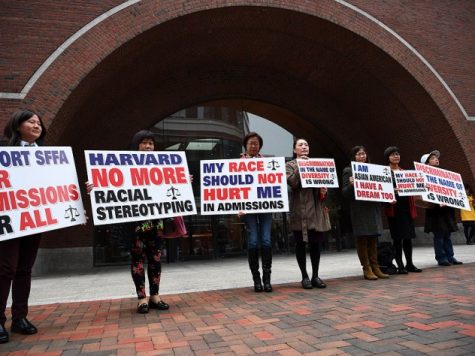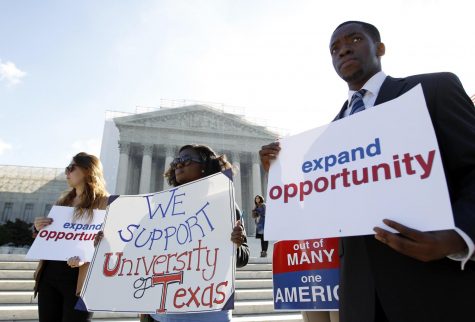I Believe in Affirmative Action—and I’m Asian
What is affirmative action?
According to the U.S. Department of Labor, affirmative action is a method of recruiting qualified minorities, women, persons with disabilities, and recovering veterans for training programs, outreach efforts, jobs, and colleges. The intention behind the process is to promote opportunities for minority groups who experience systematic and systemic disadvantages.
Affirmative action was first instated in 1961, when President John F. Kennedy included affirmative action in Executive Order (E.O) 10925, “to ensure that applicants are treated equally without regard to race, color, religion, sex, or national origin,” according to the American Association for Access, Equity, and Diversity. Affirmative action would spark decades of controversy, and here’s why:
The White Zero-Sum Game
 Reverse racism is the idea that, as a result of admitting people of color (POC) into college, white Americans will have a racial disadvantage in the college application process. One of the earliest lawsuits against affirmative action at UT was Fisher v. University of Texas at Austin. Abigail Fisher was a white female who was rejected from UT. After being denied admissions, she filed a lawsuit claiming that her rejection was based on a racial premise, which violated the equal protection clause of the Fourteenth Amendment. Although the district court favored UT, Fisher v. University of Texas at Austin perpetuated the idea for many white students that reverse racism existed in the college application process and posed a threat to equality.
Reverse racism is the idea that, as a result of admitting people of color (POC) into college, white Americans will have a racial disadvantage in the college application process. One of the earliest lawsuits against affirmative action at UT was Fisher v. University of Texas at Austin. Abigail Fisher was a white female who was rejected from UT. After being denied admissions, she filed a lawsuit claiming that her rejection was based on a racial premise, which violated the equal protection clause of the Fourteenth Amendment. Although the district court favored UT, Fisher v. University of Texas at Austin perpetuated the idea for many white students that reverse racism existed in the college application process and posed a threat to equality.
College admissions for students like Abigail Fisher is a zero-sum game. She believes that diversity was the sole reason for her rejection despite the holistic process.
Holistic Process
Along with the “white zero-sum game,” other opponents of affirmative action argue a merit-based, race-blind process. Right now, the U.S. follows a holistic process: admissions officers view the whole applicant, not just the grade point average (GPA) or test score. Parties opposing affirmative action believe that college admissions should be based solely on scores, GPA, and achievements. In an article titled “Higher Education Needs More Affirmative Action” published by Inside Higher Ed, Margaret Chin argues against a meritocracy by sharing her story of having not-so-outstanding SAT scores but being a first-generation college student from New York City. She was admitted to Harvard University, and, despite having low test scores, she recruited more students of color, advocated against discrimination, published national articles, and wrote her own books. She achieved amazing success because of affirmative action and the holistic process. She wrote, “‘I hope… [that Asian Americans] will not be used to deny educational opportunities to the disadvantaged and to preserve success only for the privileged.” Rather, her background growing up in public housing, attending a public school, and being a daughter of working-class immigrants contributed to her character. Through the holistic process, not solely a merit-based framework, students of color from disadvantaged backgrounds have an equal opportunity among white affluent applicants.
Through the holistic process, students of color aren’t barred by the privilege of testing like Chin. According to the College Board database, students from families with an annual income of more than $200,000 score an average of 388 points higher on the SAT than those from families making less than $20,000 annually. The majority of students at underfunded and high-poverty schools and neighborhoods of color, especially Black and Indigenous People of Color (BIPOC), and they have a clear disadvantage in testing, academics, quality of a school, and resources—not including generational trauma, police profiling, redlining, hate crimes, abusive households, language barriers, incarceration, or other non-recorded or popularized racial practices.
The argument that colleges should rely on a meritocracy completely disregards systematic disadvantages for low-income students of color. For example, Julian Castro scored 1210 on his SAT for Stanford University, a score lower than the median matriculating student. However, Stanford regarded Castro’s background and made the decision holistically. Racial diversity is important to “equal the playing field” and support the leadership of students from marginalized communities.
Unspoken Privileges
 There’s also silent affirmative action. It’s tucked far away from media spotlights, and it’s an affirmative action that benefits affluent white students. In Harvard admissions, legacy students account for 22% of white American admits! Three-quarters of recruited athletes were also white American, especially in very wealthy sports such as golf, lacrosse, sailing, and water polo. In a way, recruiting for wealthier sports is a backdoor for affluent white students—its own silent affirmative action. Favoring legacies, donors, and athletes benefit white Americans disproportionately compared to all students of color (Asian, Hispanic, Indigenous, and Black American). There are a lot of advantages behind the scenes in college admissions, which puts racial comparisons with white Americans into question at institutions like Harvard.
There’s also silent affirmative action. It’s tucked far away from media spotlights, and it’s an affirmative action that benefits affluent white students. In Harvard admissions, legacy students account for 22% of white American admits! Three-quarters of recruited athletes were also white American, especially in very wealthy sports such as golf, lacrosse, sailing, and water polo. In a way, recruiting for wealthier sports is a backdoor for affluent white students—its own silent affirmative action. Favoring legacies, donors, and athletes benefit white Americans disproportionately compared to all students of color (Asian, Hispanic, Indigenous, and Black American). There are a lot of advantages behind the scenes in college admissions, which puts racial comparisons with white Americans into question at institutions like Harvard.
Students who attend private schools are also more likely to attend these institutions and go to college. According to the National Center for Education Statistics, 67% of private elementary and secondary school students were white. The Washington Post found that 43% of the nation’s private school students attended virtually all-white schools, compared to 27% of public-school students. From athletics, generational wealth, and academics without the disadvantage of racism and systemic oppression, affluent white families have a grip on a “silent affirmative action” in the college application process.
Why Does Students for Fair Admissions v. Harvard Bother Me So Much?
After explaining the technicality and having summarized details of affirmative action and racial injustice, I’m going to approach the principal question: Why do I, an Asian American, care so much?
In Students for Fair Admissions v. Harvard University, the case claimed that Harvard discriminates against Asian-American applicants in the admissions process. Students for Fair Admissions (SFFA) isn’t an Asian organization—it’s very much a white organization founded by Edward Blum, a white legal strategist who advocates against laws involving race and ethnicity. He found an anonymous group of Asians who were rejected from Harvard and pursued the case . The publicity and the organization bothered me because white American writers, journalists, and news reporters perpetuated an anti-affirmative-action sentiment from the Asian American community—which is false. There are Asians who don’t support affirmative action, and there are Asians who do. According to an AAPI Voter Survey with 1,569 Asian Indian, Chinese, Filipino, Japanese, Korean, and Vietnamese participants, 70% of Asian Americans support affirmative action.
Racial weaponization of Asian Americans genuinely frightens me, and I know many Asian Americans who feel used as a pawn to undermine support for affirmative action. It’s worse for low-income Asian Americans or native Asians, naïve to the American application process, who are being used by white organizations to re-establish normalcy. Why does Students for Fair Admissions v. Harvard bother me so much? Because my community is once again being used for another community’s agenda. I’ll only say this once: don’t use the Asian American community to support reverse racism and don’t lump the Asian American narrative with the white American community. In fact, don’t use any colored community.
The Conclusion: I Can’t Escape the Elitism
Any community of color will experience racism—some definitely more than others. Taking into account racial background is so important in understanding the entire context of a student’s generational trauma, systemic disadvantages, and community’s underrepresentation in an academic field. I urge students to understand other people of color. Most importantly, racial background is not the determining factor or the only factor in the application—but it should be taken into context. I wish to escape the elitist discussion of affirmative action, but arguments, especially those that use Asian Americans by non-Asian communities, against considering racial background, forces me back into the debate—every single time, exhaustingly.

Ali Wu, a senior, is excited to represent art in the Keynote with Siona this year! She aims to connect the Keystone community through writing and comics!...




